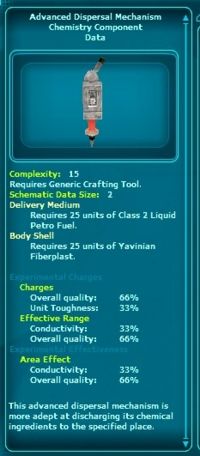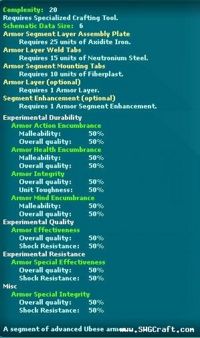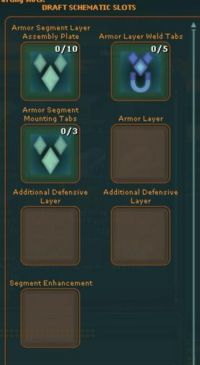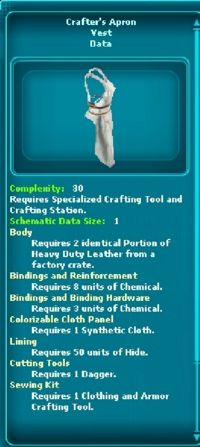Using Schematics (Game Mechanics)
| This article or section needs proper wiki formatting. |
Game Mechanics - Mechanics Category
SWGANH Wiki is a repository of Star Wars Galaxies Developer information. This site is only meant to be used by SWGANH Developer team.
|
|
General Draft SchematicSchematics are basically blueprints for anything you can build. They include designs for weapons and other devices, recipes for foodstuffs, and patterns for items of clothing. You Access your list of schematics through your Datapad (Ctrl+D). Double clicking on any schematic will bring up a description of that item, along with a list of the resources and other components required to build that object. Every item in the game requires specific components to craft. In many instances, these components will simply be resources. To craft a survival knife, for example, you might need several units of metal and a few units of polymer alloys. More complex items are actually composed from other crafted objects, or a combination of resource and crafted components. A blaster requires some resources, but also calls for a power cell, which is a separate craftable item. To build a blaster, you must first build (or buy) a power cell. Some items allow for optional components (you might be able to add spices to a meat stew or a scope to a rifle). The components are not required to complete the item, but may enhance the final product in some way. You can view the components required for any item by reviewing the object's schematic in your Datapad or through a crafting device.
Parts of General Draft Schematic1. Complexity
Complexity This stat governs several things. First it determines what type of tool and crafting station a player must use in order to have this schematic come up as an option to be crafted. Second, it determines the base length of production time in factories and in the crafting tools output production of a prototype item. The value listed within the schematic itself serves as a base figure. For every experiment attempt made (even if unsuccessful), this value is increased by one point.
This lists the minimum crafting tool type that must be used for a particular schematic. Schematics are linked in some cases to being used only by certain tools. Take for example Generic Crafting Tools and Lightsaber Crafting Tools. Both have some items in them with complexities of between 1-15. Generic tools can craft most objects ranging from 1-15 complexity. Due to certain items being restricted to certain tools; light saber items are craftable only by light saber tools,(even though it is 10 complexity). Specialized tools follow the same logic. A schematic that is designated to be used with a Structure and furniture tool can only be used with a structure and furniture tool, however since the structure is hierarchal, a lower tiered item can be crafted from a higher tier crafting tool in the case of the advanced dispersal mechanism below which only requires a generic crafting tool to create it, but in which a food & chemical tool can also be used to craft and experiment upon it. At times some schematics may even require both specific tools in addition to stations. This is likely linked solely to the complexity of the item where all objects of complexity 21 and higher would require a specialized tool in conjunction with a specialized crafting station (public or private depending on the complexity level) of that type.
This originally was intended to act as a sink for data pad points when a manufacturing schematic of this type was created. Each point in this would likewise take a point away from the datapad storage allotment, however all manufacturing schematics only take up one point.
1. Resource
Resource slots account for harvestable resources that are required to proceed with crafting. These resources can be general to a particular class of resource (minerals, metals, chemicals, polymers, flora, rice etc) or they may be specific to a particular type of resource such as Kammris Iron, Duralloy Steel etc. The given resource requirement for that slot must be filled with the matching type of resource.
Sub components directly add (or takes away from) to the item's stats. Components do not act as multipliers in the crafting process. For example a curved sword has a maximum experimentation range of 10-50 min damage and 100-255 max for min and max damage. If we add an advanced sword core that was experimented to have 25 min damage and 50 max damage, the minimum we could have on this weapon with 0% experimentation is 35-150. The maximum we would have after 100% experimentation would be 75-305.
Optional slots are like sub component slots in that they often require a crafted item, although in some cases loot items are accepted. Optional slots are just as their name says, optional. They are not required to complete the item however adding an optional component will affect the item by directly adding (or decreasing from) the item's stats and do not act like multipliers.
Experimental Lines are what the player uses to allocate experimentation points into during the process of experimentation on an item. Experimental lines are made up of experimental properties. Experimental properties are the sub stats that are affected by the allocation of points. These stats are what give an item its usable properties and each property has its own resource weighting scheme based upon a percentage meaning the resource quality designated for that particular stat such as overall quality and shock resist for armor. In this case, the overall quality and shock resist of the materials used in the draft slots will be factored in with a 50/50 ratio to convert these resource stats into an experimentation rating ranging from 1 to 100%. Each property is checked individually on its own roll during the crafting process from assembly stage through to every experimentation attempt. This means that within the experimental durability line in armor for instance, there are 4 distinct rolls made each time a player allocates one experimentation point. Each roll has its own success chances and stats on the item can differ depending on the roll made for each attribute. If the player allocated all points at once then it is considered one attempt. In this case each stat would make one roll.
For a list of available slot component types and optional items, please visit the respective craft profession pages for: Architect:
Looted Components & Optional ItemsSee Loot Components for more information Looted SchematicsSee Loot Schematics for more information
Using Schematics In FactoriesSee Factories for more information. Source References
|
Bold text |



